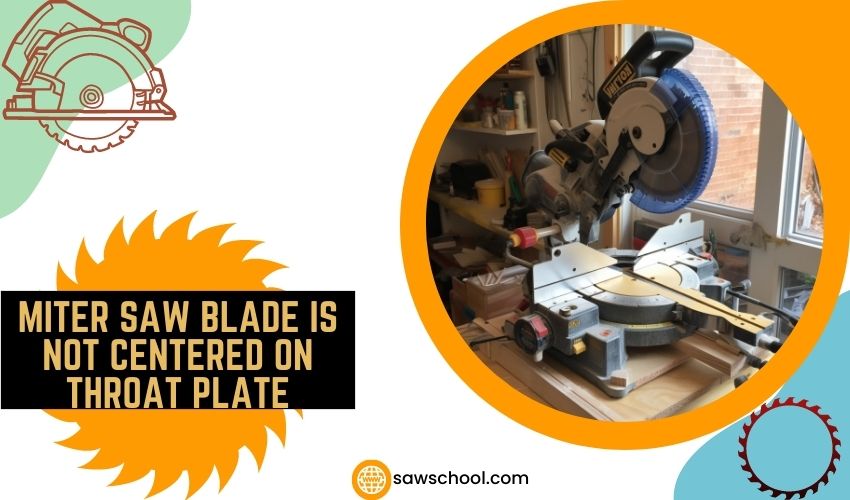It’s not fun to see an unaligned miter saw, no matter whether it’s new or suddenly showing inaccuracies. Woodworking requires preciseness, and that’s not something you can achieve when the miter saw blade is not centered on throat plate.
The blade may not be aligned properly, or the throat plate might have gotten damaged. Regardless of what the reason is, there are a few solutions you can attempt.
If you want to go through the details of how you can fix this issue, make sure to read the entire article.

Miter Saw Blade Is Not Centered On Throat Plate: Reasons And Solutions!
It’s essential that you find out what’s causing the problem. Once you get that straight, you can fix the issue and get precise cuts with your miter saw. The following points will tell you about some possible reasons and how you can fix them.
Improper Blade Alignment
If the blade is not aligned perfectly, it can cause the throat plate and blade to stay in improper proportion. Whether you’ve gotten a new miter saw or replaced the blade with a new one, proper alignment is the key to preciseness. You can never get accurate measurements on your workpieces if the blade is not set properly.
How you can align your miter saw can vary depending on the brand and the model. So, the best solution in this situation is to check the user manual of your specific model to see how to adjust the blade. It’s one of the most basic information, and your user manual will certainly contain that information.
You can also search for instructions online by putting the specific model name. This will make the issue easier to solve. The same can be said for the fence. The blade and the fence have to be proportionate in order for the material to be cut accurately.
Bent Blade
The blade might be perfectly aligned but bent. One of the most common reasons why the blade is not centered on the throat plate is that it’s bent. Using a damaged blade is not beneficial in any way. You can neither get the cuts you desire nor ensure safety with the blade. So, if you suspect that the blade is damaged, it’s time to get a new blade.
Whether the blade is at fault or not can be easily determined. Remove the blade and replace it with another one. You can use an old blade just to check if changing the blade fixes the issue. Once you are certain, then you can invest in a new miter saw blade.
This can happen with your new miter saw too. Sometimes the blade can bend during the shipping procedure. It’s not that uncommon. As I mentioned before, you shouldn’t keep using a bent blade. Replace it as soon as you can.
Damaged Throat Plate
The throat plate can be out of shape too. Just like the blade, the throat plate can get damaged during shipping, causing the blade not to align with the throat plate. If this is a newly bought miter saw, the best approach would be to reach out to the manufacturer.
In case you’ve gotten the miter saw from a good brand, they’ll be prompt in solving the issue. They may tell you how to fix the damaged throat plate or replace the miter saw, depending on the warranty policy they have.
If the miter saw isn’t new and you’re certain that the throat plate is at fault, there’s a solution for that too. You can either buy a replacement part for the specific model or make a throat plate on your own. If you love DIY projects, there’s no reason why you shouldn’t build your own throat plate out of wood. Besides, it helps customize your miter saw too.
Let’s say you are not into creating DIY inserts for your miter saw. There are store-bought options that you can go for too. Several options including plastic, wood, and tape-like material are available.
For instance, No products found. is for placing on top of your existing insert. If your miter saw throat plate has a large gap and wood pieces keep going through the gap, it can be an excellent option for you. It turns your miter saw insert into a zero-clearance insert.
All you have to do is to tape it over the insert, align the blade, and then cut through the blade. There are also other options that will require you to remove the existing insert and install the new one. They’re a suitable solution when the blade hits the throat plate, and you want to entirely replace the existing throat plate.
How To Make A Zero Clearance Throat Plate
Making a zero-clearance throat plate will certainly solve the issue you’re having. If you don’t want to buy a new throat plate and want to customize your miter saw, this is a very cool way of doing so. So, let’s get started on how you can do that.
- Remove the throat plate that came with your miter saw.
- Take a piece of plywood larger than the throat plate. The thickness should be the same as the insert of your miter saw.
- Now, place the throat plate of your miter saw on top of the plywood board and outline the shape. Don’t forget to mark the screw holes too.
- Cut the plywood piece along with the outline and use a drill to screw the holes in the plate.
- Smoothen the edges and place the board on your miter saw where the throat plate is supposed to be. Now, fix it in place with the screws.
- Once you’re finished installing it, it’s time to make the slit. Make sure that the blade is aligned perfectly. Now, spin the blade and make the cut on the plywood, and you’ve gotten your zero clearance throat plate.
If you want a visual demonstration of the process, here’s an excellent video of how to make a zero-clearance insert for your miter saw. Let’s see this video-
Some Tips To Remember

- Regardless of what you are fixing on your miter saw, make sure that’s not connected to the power source.
- Avoid using a bent or blunt blade on your miter saw. It’s not only ineffective in cutting in accurate measurement but also causes kickbacks and compromises your safety.
- If you are having difficulty using the miter saw, troubleshoot the issue and fix it before using it again. Power tools can be dangerous and cause sudden injuries if any of the safety features are missing.
- Do not attempt to fix any part of the miter saw if it’s still under warranty. Instead, contact the manufacturer to get the issue fixed.
- If you are getting any replacement parts for your miter saw, make sure to double-check the model. Every model requires a different-sized component, and a component made for a specific model will not fit another miter saw model.
- Avoid using the miter saw without any of the components, even if it’s possible. For instance, you can still operate the miter saw without the blade guard or the throat plate. That doesn’t mean that you should. You can also check my article on can I use my miter saw without the blade guard if you are interested.
Frequently Asked Questions

What does the throat plate do on a miter saw?
Many users don’t understand the function of the throat plate on their miter saws and attempt to use the tool without this part. As small as the component is, it plays an important role in ensuring that the miter saw functions effectively.
It not only makes the material cut more smoothly but also prevents small parts of the material from getting stuck inside the blade or the miter saw. So, you cannot use the miter saw with its highest potential without the throat plate.
What does a zero clearance insert do on a miter saw?
A zero clearance kerf plate ensures that the gap is reduced between the edges. When the gap is broad, pieces of wood can get inside through the gap. In addition, it also reduces tear-out because there’s almost no space between the blade and the split. The less space there is, the better your cutting experience will be.
So, if you have a damaged insert on a miter saw, it’s time to replace it with a zero-clearance insert.
Final Words
As you can see, it’s not the end of the work if your miter saw blade is not centered on throat plate. It’s one of those minor issues that you can fix for yourself in no time. The best approach to this problem is to make a new insert or buy a new one to replace the existing one. However, it will only solve the problem if the throat plate is at fault.
In case your blade is not aligned properly or bent for some reason, changing the throat plate won’t help. So, make sure that you know what’s causing the issue before fixing it.
